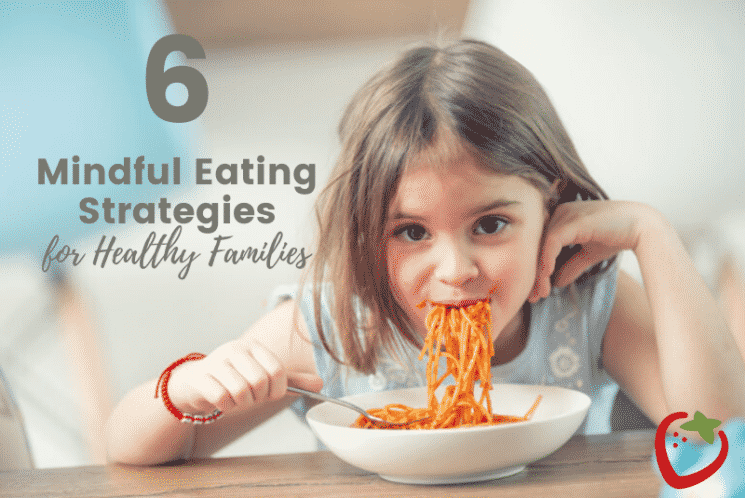6 Mindful Eating Strategies for Healthy Families
Learn mindful eating strategies that the whole family can use! Foster a healthy relationship with food with these six simple exercises you can practice daily.

Whether you have a family member struggling with weight, or you’re just tired of scarfing down food on the go, mindful eating offers a chance to re-calibrate your family’s relationship with food. These simple steps can help you and your kids learn the basics of mindful eating so you can have healthier and more nourishing mealtimes.
What is Mindful Eating?
Mindful eating is simply honoring the space between wanting a piece of food and eating it. It’s seeing your meal on your plate and then eating it with intention, being full present for the food.
The psychiatrist Victor Frankl put it this way:
“Between stimulus and response there is a space. In that space is our power to choose our response. In our response lies our growth and our freedom.”
When we take the time to be fully present with our food (and teach our kids to do the same) we can eat in the way that feels best for our bodies in the short and long term.
6 Steps to Mindful Eating
Follow these six steps to practice mindfulness at each meal.
- Establish three periods of time during the day for intentional, purposeful eating.
- Create a space during meals free of common distractions. (no phone, books, computer, magazine, TV, etc). This can be uncomfortable! Many older kids like to scroll on their device or have a show on the t.v. while they are eating. Putting away devices and reading material is critical for eating mindfully.
- Chew slowly and experience each bite. If you are too busy to eat your food slowly, you are too busy. Put the food down, and wait until you have time to sit down and fully chew your food. I’ve timed a lot of meals, and most meals, chewed slowly takes fewer than 10 minutes.
- Identify the flavors, textures, and aromas of each bite. This might be the most fun part for you and your kids! When really tasting your food, you can see and appreciate healthy foods in a new way.
- Finish eating each bite completely before you fill your fork again.
- Assess hunger mid-meal to see if you are satisfied, almost satisfied, or still hungry. You don’t have to finish your meal, ever. This is where you listen to your body and let it decide if you’ve had enough.
Troubleshooting Your Practice
Practicing mindfulness can be trickier than you think, especially when you’re just getting started! If you feel your mind wandering, return to focus on eating with these concrete steps.
- Take a deep breath midway through the meal.
- Ask yourself if enough time has passed for hunger or satiety signals to reach your brain.
- Put your fork down, and take a drink of water.
- Check in with your belly. How does it feel?
- Evaluate whether or not your meal becomes less satisfying as you continue to eat. It’s common for the first few bites, when we are the hungriest, to be the most pleasurable of the meal. As we get full, the pleasure diminishes.
- Identify distractions. Are you still paying attention to your meal, or has your mind wandered to other things? Are you allowing yourself to absorb other distractions in your environment that you may not have control over?
Best Books About Mindful Eating
These books have been inspirational to me as I’ve learned to practice mindful eating:

Natalie Monson
I'm a registered dietitian, mom of 4, avid lover of food and strong promoter of healthy habits. Here you will find lots of delicious recipes full of fruits and veggies, tips for getting your kids to eat better and become intuitive eaters and lots of resources for feeding your family.
Learn More about Natalie
Thank you so very much for all your hard work on this! It will be a huge help to me!! 🙂
This is Amazing! We’ll give it a try. Thank You!
What you are doing is very valuable. Thanks for sharing!